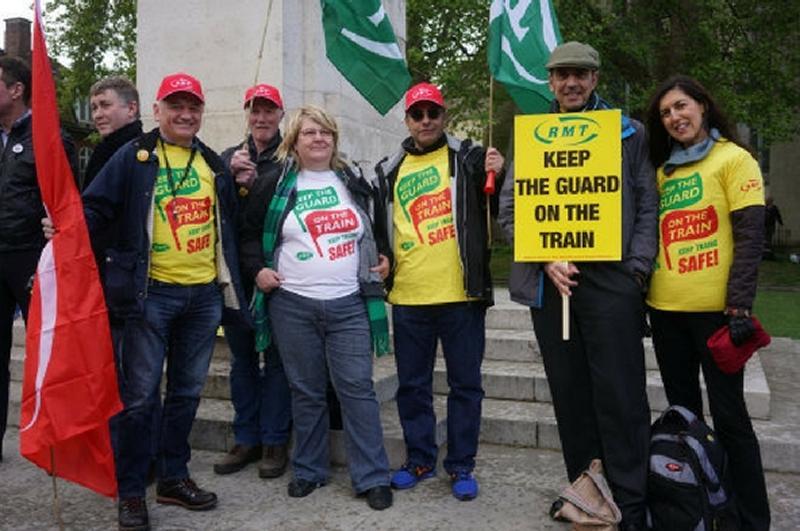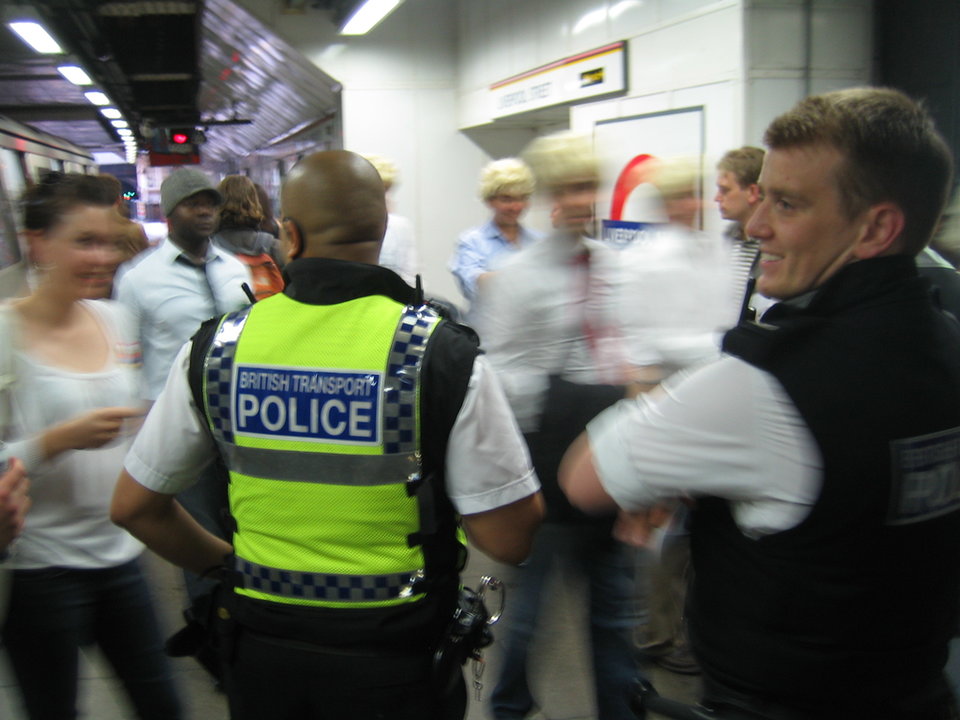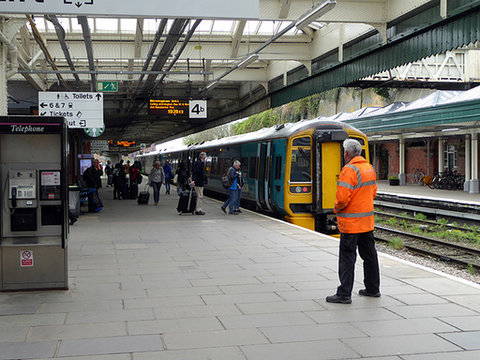Thousands of Southern services are running with a driver alone

Image: Tom Lee / RSSB
Disabled access and platform safety still in dispute
On 26 April, RMT marked the three-year anniversary of its campaign against DOO with a protest outside the London headquarters of Keolis UK. The thrust of RMT’s campaign is that removing onboard train guards or conductors – 15,000 Southern services have reportedly been run without a second person onboard since DOO was introduced in 2017 – represents discrimination against disabled passengers, as without a guaranteed staff member onboard the train or at rail stations, elderly users or those with impaired mobility may not get the help they need to board or disembark.
“Despite all the promises that there would continue to be a second person on trains, ministers have now admitted thousands of Southern services are running with a driver alone,” said RMT general secretary Mick Cash in a statement. “Disabled and vulnerable passengers were once guaranteed a guard on their services to provide assistance and protection. That is now no longer the case, as we can see in this appalling increase in discrimination against disabled and vulnerable passengers.”
Safety at the platform is also still in question in some quarters, as critics of DOO claim that the limited window for drivers to perform safety checks increases risk of injury when boarding and disembarking, otherwise known the platform-train interface (PTI).

Image: Guard Protest / RMT
On platform safety, there is evidence that DOO has no negative impact. The Rail Safety and Standards Board (RSSB), a safety watchdog owned by rail industry stakeholders, has conducted research into the risks presented by driver door operation during train dispatch. It found that between 2010 and 2015, there were more platform safety incidents on conductor-operated trains (1.35 fatalities and weighted injuries (FWI) per billion passenger journeys) than DCO services (0.87 FWI per billion passenger journeys).
RSSB director of standards Tom Lee notes that RIS-3703-TOM, the standard for train dispatch and platform safety, “does not prescribe a time limit for drivers, guards or platform staff to assess whether a train is safe to depart. It does require that sufficient time is allowed taking into account various factors at each location and for each traction type.”

Image: Beth Granter
Snakes on the train: onboard safety concerns
While current evidence seems to suggest that platform safety (if not disabled access) can be maintained with driver-controlled trains, what about passengers’ onboard safety? Given that trains moving between stations aren’t easily accessed by the British Transport Police (BTP), there’s a strong argument to be made that retaining a guard presence on trains provides a powerful deterrent to onboard assaults, harassment and antisocial behaviour.
In 2016, Care2 head of UK campaigns Beth Granter set up a petition to support the Keep The Guard On The Train campaign. She was initially inspired by a desire to support the workers’ strike, but also by her own experiences, and those of others, of onboard sexual harassment and the differing outcomes she had seen based on the presence (or lack of) a train conductor.
“On a train to Brighton that had no guard, I once saw a man surreptitiously taking photos of a young woman’s legs, but there was nothing I could do until I got to Brighton station to report it – and then the police said it was too late as there wasn’t any CCTV,” she says. “On another train to Brighton, I saw a drunk man sexually harassing a woman and was able to get the train guard to intervene and check the woman was okay. As soon as the train guard stepped in, the man stopped the harassment. The guard even made sure that the man didn’t cause trouble for the woman after she left the train.”

Image: Visually impaired woman in a lift with an SWR employee / South Western Railway
Granter recently spoke at an International Women’s Day demonstration against DOO in London, organised by the Association of British Commuters, during which the group delivered Granter’s petition – with nearly 99,000 signatures at the time of writing – to the Department for Transport. The association has argued that passengers in England have never been properly consulted about DOO, and that studies have not considered the experiences of women and disabled passengers.
“I read out comments from people who had signed the petition, to show people how taking away guards would affect passengers,” Granter says. “Not only is the guard able to step in and practically help to stop harassment, but the harassment is less likely to happen in the first place. Men harass women when they think they can get away with it – they do it a lot less when there are authority figures present. Guards make passengers feel safer, and they can help people with disabilities to board and leave the train safely.”
Guards make passengers feel safer, and they can help people with disabilities
For operators, having the perception of a safe service is almost as important as actually providing one

Image: BTP / Gordon Joly
Safety on trains: do we know the whole story?
RSSB’s research tells a different story.
“A conductor provides a visible presence with the opportunity to deter physical and verbal assault on passengers, but the reported data shows that there is a higher rate of abuse on trains operated with a conductor,” says Lee.
While RSSB’s data shows, as in the case of platform safety, a higher rate of injuries and fatalities due to onboard assault on conductor-operated trains than driver-operated services, the group acknowledges in its own 2018 DCO report that “it is not tenable that the presence of a conductor has a detrimental effect on the risk from assaults”.
The difference can be explained by a number of factors, RSSB said, including regional variation and the possibility that the presence of a conductor may increase the reporting of violent assaults. Nevertheless, the data has led RSSB to conclude that the presence of guards has little effect on the rate of assaults on trains.
Of course, merely tracking violent assault doesn’t necessarily reveal the full story. Many passengers have experienced sexual harassment or antisocial behaviour onboard trains that might not qualify as assault, but remain a problem and a huge disincentive to use public transport, especially among those who are at risk of being victimised by passengers around them.
Even as official statistics show that violent crime and sexual offences are both on the rise across UK railways, the BTP has noted the impact that confidential text-based reporting service 61016 and campaigns such as Report It To Stop It, which encourages reporting sexual offences, have had on the force’s knowledge of these crimes.
It is reasonable to assume, then, that there is still far more to learn about the frequency of traditionally overlooked behaviours like sexual harassment, and paying closer attention to the views of those passengers who have experienced it could be an important and thus far under-used resource for rail safety stakeholders.

Image: Train Platform / John Lucas
“Hundreds of people signing the petition have described incidents that happened to them or their loved ones, mostly sexual assault or harassment by men targeting women,” Granter says. “Many women signing the petition have said that they will be afraid to travel without a guard; some even said they will not travel without a guard.”
For train operating companies, the prospect of large sections of their potential customers being too nervous to use their services should be worrying. For operators, having the perception of a safe service is almost as important as actually providing one. The answer might not lie in banning DCO outright on safety grounds, but among other possibilities – such as more extensive use of onboard CCTV to identify perpetrators – committing to the presence of at least one non-driver staff member on every train could go a long way to making vulnerable passengers feel safe and supported on their journeys.